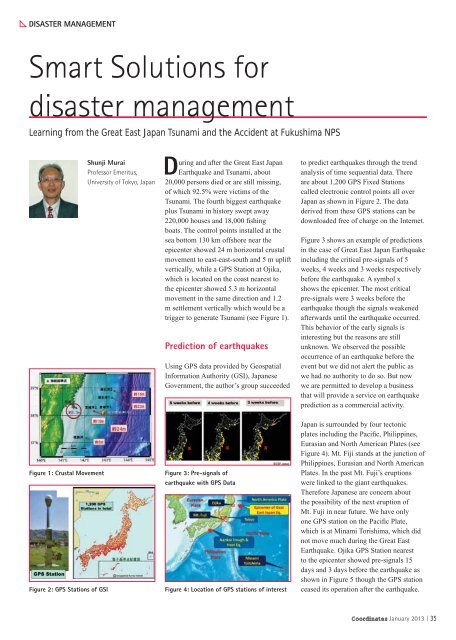Download - Coordinates
Download - Coordinates
Download - Coordinates
Create successful ePaper yourself
Turn your PDF publications into a flip-book with our unique Google optimized e-Paper software.
DISASTER MANAGEMENT<br />
Smart Solutions for<br />
disaster management<br />
Learning from the Great East Japan Tsunami and the Accident at Fukushima NPS<br />
Figure 1: Crustal Movement<br />
Figure 2: GPS Stations of GSI<br />
Shunji Murai<br />
Professor Emeritus,<br />
University of Tokyo, Japan<br />
During and after the Great East Japan<br />
Earthquake and Tsunami, about<br />
20,000 persons died or are still missing,<br />
of which 92.5% were victims of the<br />
Tsunami. The fourth biggest earthquake<br />
plus Tsunami in history swept away<br />
220,000 houses and 18,000 fi shing<br />
boats. The control points installed at the<br />
sea bottom 130 km offshore near the<br />
epicenter showed 24 m horizontal crustal<br />
movement to east-east-south and 5 m uplift<br />
vertically, while a GPS Station at Ojika,<br />
which is located on the coast nearest to<br />
the epicenter showed 5.3 m horizontal<br />
movement in the same direction and 1.2<br />
m settlement vertically which would be a<br />
trigger to generate Tsunami (see Figure 1).<br />
Prediction of earthquakes<br />
Using GPS data provided by Geospatial<br />
Information Authority (GSI), Japanese<br />
Government, the author’s group succeeded<br />
Figure 3: Pre-signals of<br />
earthquake with GPS Data<br />
Figure 4: Location of GPS stations of interest<br />
to predict earthquakes through the trend<br />
analysis of time sequential data. There<br />
are about 1,200 GPS Fixed Stations<br />
called electronic control points all over<br />
Japan as shown in Figure 2. The data<br />
derived from these GPS stations can be<br />
downloaded free of charge on the Internet.<br />
Figure 3 shows an example of predictions<br />
in the case of Great East Japan Earthquake<br />
including the critical pre-signals of 5<br />
weeks, 4 weeks and 3 weeks respectively<br />
before the earthquake. A symbol x<br />
shows the epicenter. The most critical<br />
pre-signals were 3 weeks before the<br />
earthquake though the signals weakened<br />
afterwards until the earthquake occurred.<br />
This behavior of the early signals is<br />
interesting but the reasons are still<br />
unknown. We observed the possible<br />
occurrence of an earthquake before the<br />
event but we did not alert the public as<br />
we had no authority to do so. But now<br />
we are permitted to develop a business<br />
that will provide a service on earthquake<br />
prediction as a commercial activity.<br />
Japan is surrounded by four tectonic<br />
plates including the Pacifi c, Philippines,<br />
Eurasian and North American Plates (see<br />
Figure 4). Mt. Fiji stands at the junction of<br />
Philippines, Eurasian and North American<br />
Plates. In the past Mt. Fuji’s eruptions<br />
were linked to the giant earthquakes.<br />
Therefore Japanese are concern about<br />
the possibility of the next eruption of<br />
Mt. Fuji in near future. We have only<br />
one GPS station on the Pacifi c Plate,<br />
which is at Minami Torishima, which did<br />
not move much during the Great East<br />
Earthquake. Ojika GPS Station nearest<br />
to the epicenter showed pre-signals 15<br />
days and 3 days before the earthquake as<br />
shown in Figure 5 though the GPS station<br />
ceased its operation after the earthquake.<br />
<strong>Coordinates</strong> January 2013 | 35
















